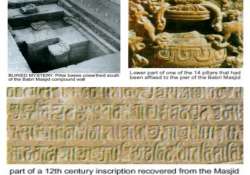Remnants of temple found beneath Babri mosque in Ayodhya, claims Muslim archaeologist
Communist historians along with a section of the media aggravated the Ayodhya issue at a time when there was a good chance of arriving at an amicable solution to the Ram Jamabhumi issue, eminent archaeologist

Communist historians along with a section of the media aggravated the Ayodhya issue at a time when there was a good chance of arriving at an amicable solution to the Ram Jamabhumi issue, eminent archaeologist K K Mohammed has said.
Mohammed was part of the team from the Delhi School of Archaeology that joined the excavation team of Ayodhya headed by Prof V B Pal. In his autobiography titled ‘Njan Bharatiyan', Mohammad claims that Left historians, Communists and an influential section of the media were hand in glove in aggravating the Ayodhya issue and leading it further from a peaceful solution.
The book claims that findings of the Archaeological Survey of India pointed to the existence of a temple beneath the structure. “Archaeological Survey came to the conclusion that remnants of a temple were indeed present under the structure known as Babri mosque, following evidences acquired from the excavation site. This was acknowledged by the Lucknow Bench of Allahabad High Court,” says the book.
Mohammed further cites evidences observed during the excavation process, of which he was a member himself, to point to a possibility of the mosque being actually built using pillars, slabs and other structural components from the temple.
“During the course of excavation, it was discovered that many of the temple pillars had foundations made of bricks. Also, it was very clear that the structure's walls had temple pillars. There were engravings of full ‘kalash' carved out of black basalt. All this was discerned after spending over two months in studying the structure,” the book says.
According to Mohammed, Left historians and the Babri Masjid Action Committee of the Jawaharlal Nehru University (JNU) succeeded in giving matters a crooked turn. The book also castigates media houses for having played a key role in turning Muslim sentiment against a peaceful reconciliation.
“It was the Left historians and their various writings which were given preference over anything else by media houses, who took concrete efforts in making those Muslim policy makers, who had ample thoughts of peaceful reconciliation, think otherwise,” Mohammed says in the book.
Mohammed further claims that Muslims were genuinely considering ‘giving the mosque back' before Leftist ‘interference' played a key role in reversing the sentiment and giving false hope to the Babri Masjid Action Committee.
“Unfortunately, this (Leftist writings) instilled courage and gave false hopes to Babri Masjid Action Committee. This resulted in a reversal of thought process amongst Muslims who had till then, been pondering wholeheartedly about giving back the mosque and settling the matter amicably.
“They came to a renewed conclusion that the mosque will not be given - a decision on which they stood rooted to. The fodder for this thought process was given solely by interference of Left historians. And had the matter been settled amicably, the nation would not have been facing many of those numerous issues, which they are, now,” he observes, adding that the nation had to pay a heavy price for the same.
Mohammed's book further points out that of the 131 people employed towards unbiased collection of excavations, 51 were Muslims and part of the Babri Action Committee. They were represented by archaeological historians like Soorajban, Supriya Varma, Jaya Menon along with a Magistrate of Allahabad High Court.
Besides evidences observed during the excavation, Mohammed's book also points fingers at a team led by Left historian and Chairman of Indian Council of Historical Research Dr Irfan Habib, for having conducted a meeting on the Babri Masjid Action Committee in the ICHR office.
“Even though it was opposed by member secretary MGS Narayan, it had little value in the presence of Irfan Habib,” he writes.